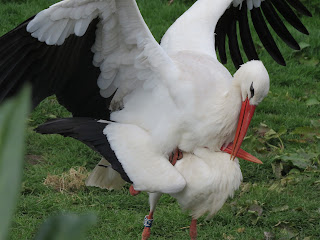OTTER! BITTERNS! SPOONBILLS! STONE CURLEW! GARGANEY!
Yes, today's trip to Minsmere had it all, in what has been one of the best days birdwatching I have experienced.
I turned up around 10 and the weather was good - it looked to be a beautiful day, with warm gentle South Easterlies blowing in from the sea. On hearing that the SAVI'S WARBLER was still present and singing I went over to Island Mere to have a look for it. It I s a very rare nesting bird in the country, so to hear it is quite a privilege. I positioned myself in the right area of the hide but I couldn't hear or see the bird which might be down to how deaf I am.
Island Mere hide
The mere itself, a large lake in the reedbeds, was fairly quiet with a couple of pairs of GREAT CRESTED GREBES, and several pairs of BEARDED TITS flying back and forth across a small pond to the right of the hide. There were at least two BITTERNS booming, the iconic reedbed sound drifting over in the peace. Then at around 10:50 a call went out and 3 SPOONBILLS appeared flying over the mere. They circled around for a while before disappearing north.
But that wasn't all. A small time later a BITTERN rose out from the pond to the right of the hide, and leisurely flew across the neighbouring mere right in front of the hide. Magnificent.
West Scrape - The deepest and more overgrown area of the scrape
Of course no trip to Minsmere would be complete without a visit to the Scrape. Pretty much every coastal reserve around the world has a scrape, and this habitat originated here at Minsmere. It's basically shallow brackish water with islands, a simple habitat that attracts lot and lots of birds.
GULLS attacking a PHEASANT that had roamed onto the scrape
As you approach the Scrape your oral senses go into overload as the sound of several thousand noisy birds all packed into one small area hit you. There were lots and lots of gulls of different species: the nesting BLACK-HEAED, of course, but also around 40+ MED GULLS - concentrated mainly on East Scrape with a few on West - with those sort of number you'd expect them to nest this year. There were also KITTIWAKE roosting on South Scrape, they nest further down the coast at Sizewell Power Station. TERNS were present with 20+ SANDWICH and 10+ COMMON.
GULLS nest on the scrape in very high densities
With winter passing there were few duck present. However bucking that trend was a male GARGANEY present on East Scrape, a MANDARIN on South Scrape (a site first for me - common in the parks of Ipswich rare in the wildness of Minsmere); and a pair of WIGEON were also still present.
MANDARIN paired up with a female MALLARD
OK I need to catch some breath. Just relax. Right.
Scrapes are designed to be attractive to migrant waders, however today was fairly unproductive. Single figures of BLACKWIT, DUNLIN and TRUNSTONE were present with a single BAR-TAILED GODWIT on South Scrape.
Around 100 AVOCETS were present today
On the subject of waders, one of the highlights of today was the STONE CURLEW present just off North Wall. In the back of a large area of grassland, in the haze of the sun it could just be made out poking its head above a patch of dock plants. With these birds showing so well at Minsmere, there's no longer the need to go all the way up to Weeting Heath - the traditional stone curlew viewing place - to watch them.
TURNSTONE in beautiful summer plumage
Which leaves the OTTER. On a pond to the left of the west hide it appeared and was present for around twenty minutes, ducking and diving. Only a few yards away were a pair of nesting SWANS, with the male very tentatively watching in case the OTTER came near. The animal was quite small, so the consensus was that it was a female. However due to the small side window of the hide and the people present I wasn't able to take a photo.
This male STONECHAT was present on the dunes
So a brilliant day all round with the exception of ducking the SAVI'S. This is why Minsmere is such a magical place, perhaps the best birdwatching reserve in the country, and added to that the season of Spring - my favourite time of year - and it truly came up with something special.































